Internet of Things (IoT) in Healthcare: Annotated Bibliography Report
VerifiedAdded on 2023/01/23
|14
|3606
|90
Report
AI Summary
This report explores the growing significance of the Internet of Things (IoT) in healthcare, analyzing its applications and limitations through an annotated bibliography of 12 articles. The report discusses various aspects of IoT, including IoMT, Cloud-IoT paradigms, and their impact on healthcare services. It highlights the benefits of IoT, such as improved efficiency and real-time data access, while also addressing challenges related to data security, patient privacy, and interoperability. The analysis covers topics like the use of wearables, cloud computing, and big data analytics in healthcare, as well as the potential of personalized healthcare systems. The report also examines the barriers to wider IoT adoption, such as communication issues, battery life, and energy management, and proposes solutions to overcome these challenges. Overall, the report emphasizes the transformative potential of IoT in healthcare, while also acknowledging the need to address associated risks and limitations to ensure its effective and secure implementation.
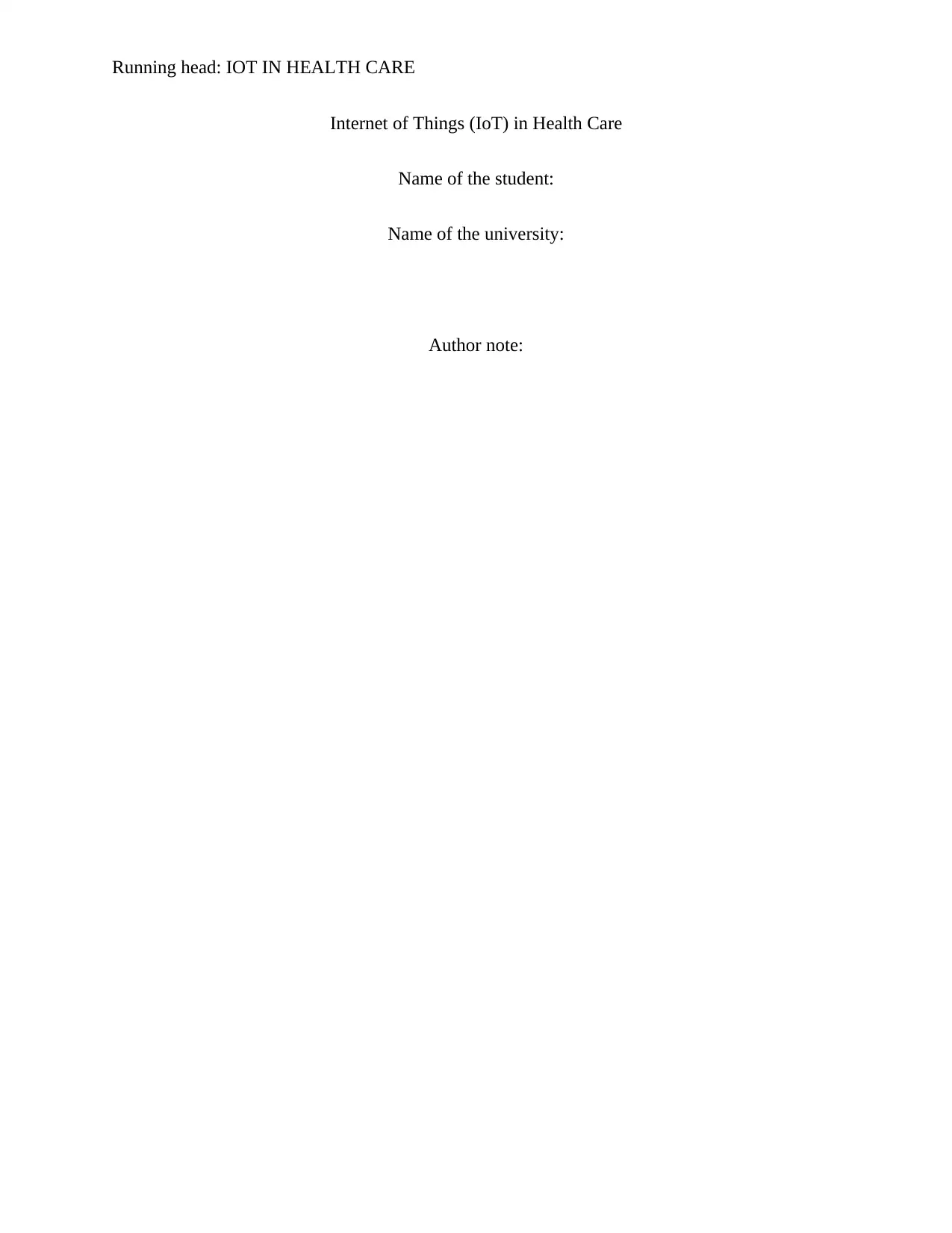
Running head: IOT IN HEALTH CARE
Internet of Things (IoT) in Health Care
Name of the student:
Name of the university:
Author note:
Internet of Things (IoT) in Health Care
Name of the student:
Name of the university:
Author note:
Paraphrase This Document
Need a fresh take? Get an instant paraphrase of this document with our AI Paraphraser
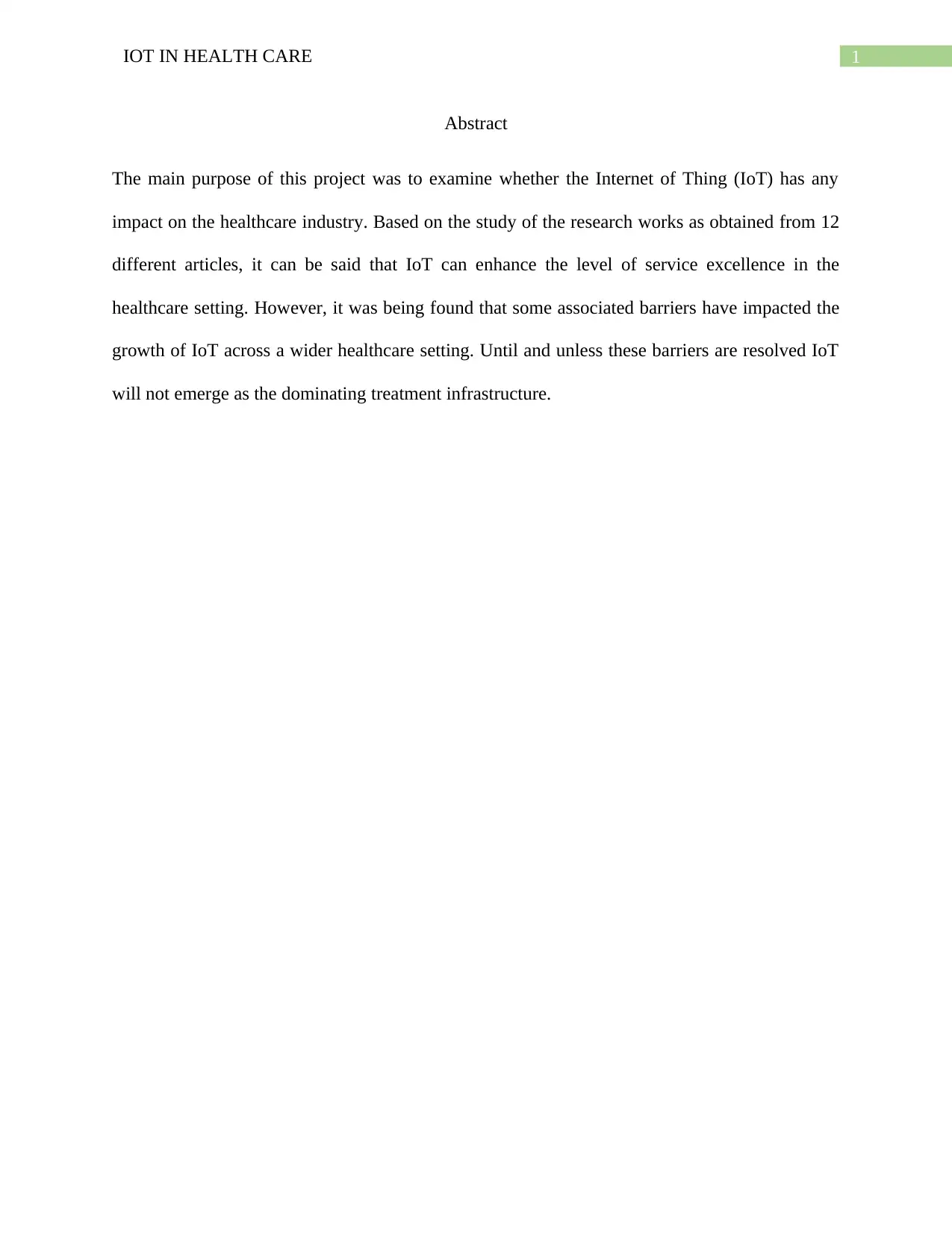
1IOT IN HEALTH CARE
Abstract
The main purpose of this project was to examine whether the Internet of Thing (IoT) has any
impact on the healthcare industry. Based on the study of the research works as obtained from 12
different articles, it can be said that IoT can enhance the level of service excellence in the
healthcare setting. However, it was being found that some associated barriers have impacted the
growth of IoT across a wider healthcare setting. Until and unless these barriers are resolved IoT
will not emerge as the dominating treatment infrastructure.
Abstract
The main purpose of this project was to examine whether the Internet of Thing (IoT) has any
impact on the healthcare industry. Based on the study of the research works as obtained from 12
different articles, it can be said that IoT can enhance the level of service excellence in the
healthcare setting. However, it was being found that some associated barriers have impacted the
growth of IoT across a wider healthcare setting. Until and unless these barriers are resolved IoT
will not emerge as the dominating treatment infrastructure.
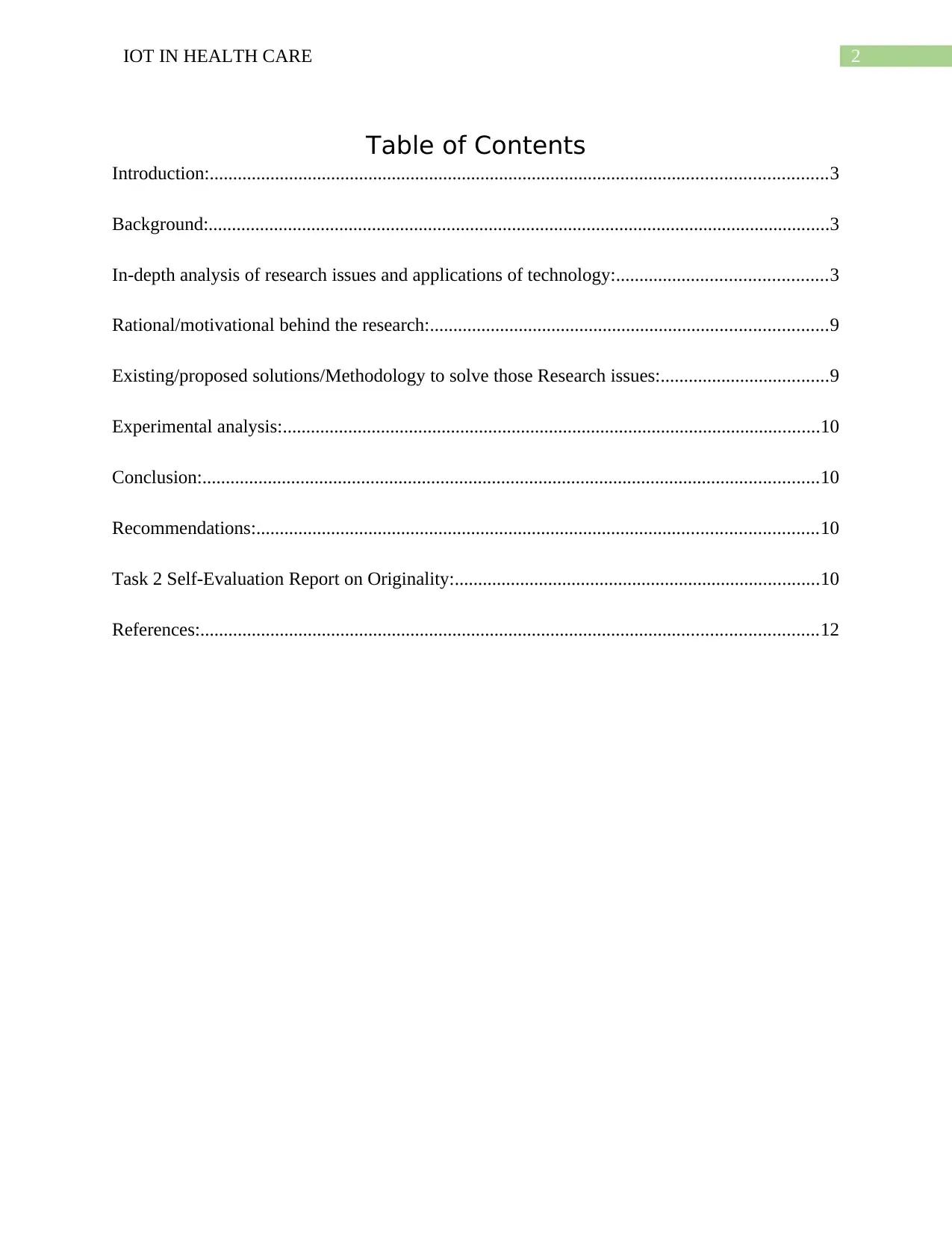
2IOT IN HEALTH CARE
Table of Contents
Introduction:....................................................................................................................................3
Background:.....................................................................................................................................3
In-depth analysis of research issues and applications of technology:.............................................3
Rational/motivational behind the research:.....................................................................................9
Existing/proposed solutions/Methodology to solve those Research issues:....................................9
Experimental analysis:...................................................................................................................10
Conclusion:....................................................................................................................................10
Recommendations:........................................................................................................................10
Task 2 Self-Evaluation Report on Originality:..............................................................................10
References:....................................................................................................................................12
Table of Contents
Introduction:....................................................................................................................................3
Background:.....................................................................................................................................3
In-depth analysis of research issues and applications of technology:.............................................3
Rational/motivational behind the research:.....................................................................................9
Existing/proposed solutions/Methodology to solve those Research issues:....................................9
Experimental analysis:...................................................................................................................10
Conclusion:....................................................................................................................................10
Recommendations:........................................................................................................................10
Task 2 Self-Evaluation Report on Originality:..............................................................................10
References:....................................................................................................................................12
⊘ This is a preview!⊘
Do you want full access?
Subscribe today to unlock all pages.

Trusted by 1+ million students worldwide

3IOT IN HEALTH CARE
Introduction:
This project describes the growing importance of Internet of Thing (IoT) in the healthcare
setting. It does so by briefly discussing 12 different articles in the form of annotated
bibliography. “Internet of Things” as according to the chosen articles has broader applications in
the healthcare setting. IoT is being used in a variety of forms like IoMT, Cloud-IoT Paradigm
and all. However, it also faces barriers in the form of communication between interconnected
things, exchange of knowledge between them, battery lifecycle of the wearable and smartphone
devices, and energy management. Some of these articles have shown the urgency to reduce these
errors and facilitate a seamless IoT environment in all healthcare setting.
Background:
This study is being constructed to identify the applicability of IoT in the healthcare
setting and to also identify its limitations. Moreover, it was needed to identify how these barriers
could be overcome to help the healthcare setting apply the IoT more effectively than they do it
currently.
In-depth analysis of research issues and applications of technology:
1. “Islam, S. R., Kwak, D., Kabir, M. H., Hossain, M., & Kwak, K. S. (2015). The internet
of things for health care: a comprehensive survey. IEEE Access, 3, 678-708.”
The article discusses a set of technologies that are increasingly becoming a part of the
healthcare industry. It discusses the Internet of Things (IoT) and identifies ways the technology
can help to effectively attain the benefits of innovations such as Big Data, Wearables and
Ambient Intelligence. These technological developments will help to conduct a variety of
medical process at a faster rate. Moreover, the efficiency of the healthcare setting will also
Introduction:
This project describes the growing importance of Internet of Thing (IoT) in the healthcare
setting. It does so by briefly discussing 12 different articles in the form of annotated
bibliography. “Internet of Things” as according to the chosen articles has broader applications in
the healthcare setting. IoT is being used in a variety of forms like IoMT, Cloud-IoT Paradigm
and all. However, it also faces barriers in the form of communication between interconnected
things, exchange of knowledge between them, battery lifecycle of the wearable and smartphone
devices, and energy management. Some of these articles have shown the urgency to reduce these
errors and facilitate a seamless IoT environment in all healthcare setting.
Background:
This study is being constructed to identify the applicability of IoT in the healthcare
setting and to also identify its limitations. Moreover, it was needed to identify how these barriers
could be overcome to help the healthcare setting apply the IoT more effectively than they do it
currently.
In-depth analysis of research issues and applications of technology:
1. “Islam, S. R., Kwak, D., Kabir, M. H., Hossain, M., & Kwak, K. S. (2015). The internet
of things for health care: a comprehensive survey. IEEE Access, 3, 678-708.”
The article discusses a set of technologies that are increasingly becoming a part of the
healthcare industry. It discusses the Internet of Things (IoT) and identifies ways the technology
can help to effectively attain the benefits of innovations such as Big Data, Wearables and
Ambient Intelligence. These technological developments will help to conduct a variety of
medical process at a faster rate. Moreover, the efficiency of the healthcare setting will also
Paraphrase This Document
Need a fresh take? Get an instant paraphrase of this document with our AI Paraphraser
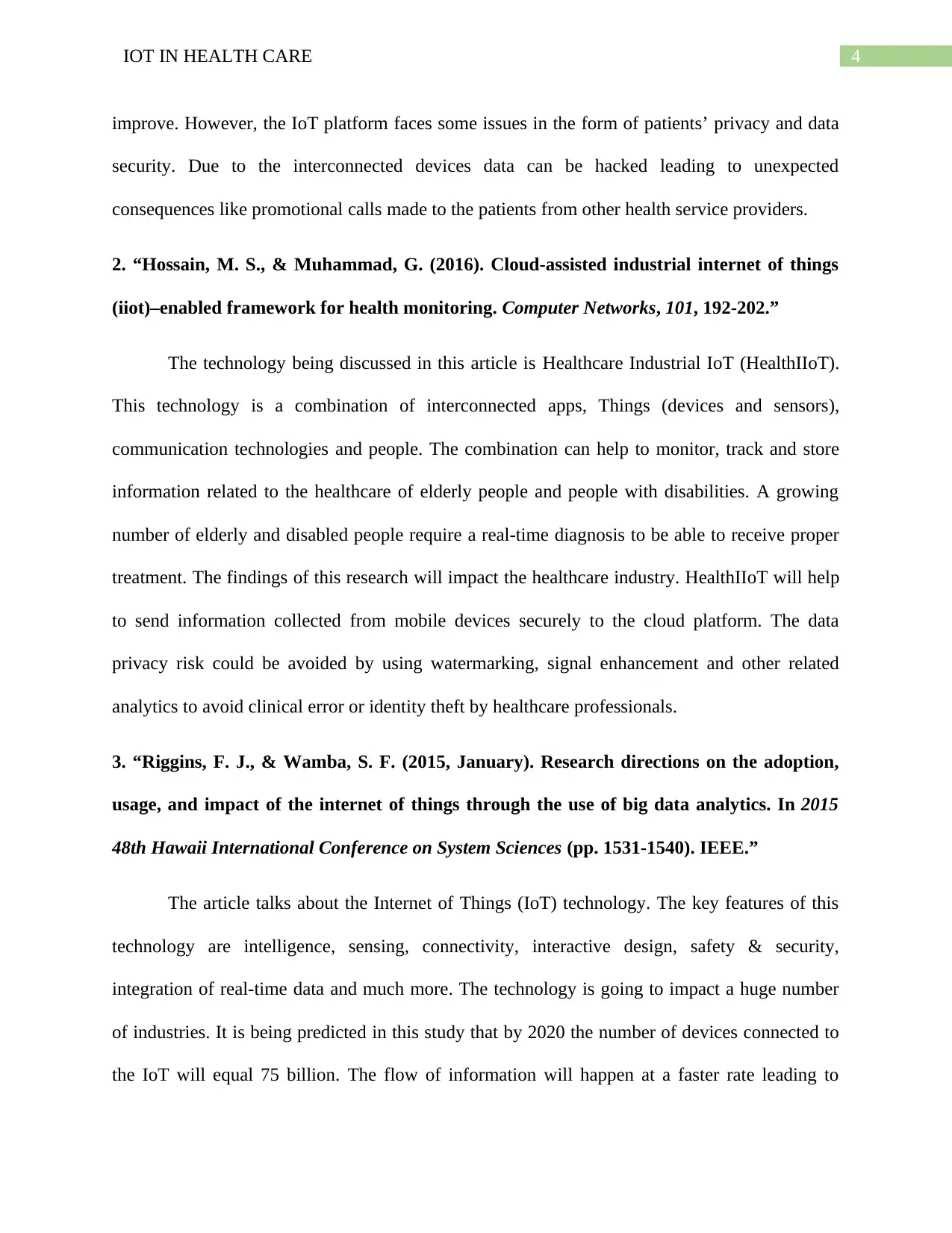
4IOT IN HEALTH CARE
improve. However, the IoT platform faces some issues in the form of patients’ privacy and data
security. Due to the interconnected devices data can be hacked leading to unexpected
consequences like promotional calls made to the patients from other health service providers.
2. “Hossain, M. S., & Muhammad, G. (2016). Cloud-assisted industrial internet of things
(iiot)–enabled framework for health monitoring. Computer Networks, 101, 192-202.”
The technology being discussed in this article is Healthcare Industrial IoT (HealthIIoT).
This technology is a combination of interconnected apps, Things (devices and sensors),
communication technologies and people. The combination can help to monitor, track and store
information related to the healthcare of elderly people and people with disabilities. A growing
number of elderly and disabled people require a real-time diagnosis to be able to receive proper
treatment. The findings of this research will impact the healthcare industry. HealthIIoT will help
to send information collected from mobile devices securely to the cloud platform. The data
privacy risk could be avoided by using watermarking, signal enhancement and other related
analytics to avoid clinical error or identity theft by healthcare professionals.
3. “Riggins, F. J., & Wamba, S. F. (2015, January). Research directions on the adoption,
usage, and impact of the internet of things through the use of big data analytics. In 2015
48th Hawaii International Conference on System Sciences (pp. 1531-1540). IEEE.”
The article talks about the Internet of Things (IoT) technology. The key features of this
technology are intelligence, sensing, connectivity, interactive design, safety & security,
integration of real-time data and much more. The technology is going to impact a huge number
of industries. It is being predicted in this study that by 2020 the number of devices connected to
the IoT will equal 75 billion. The flow of information will happen at a faster rate leading to
improve. However, the IoT platform faces some issues in the form of patients’ privacy and data
security. Due to the interconnected devices data can be hacked leading to unexpected
consequences like promotional calls made to the patients from other health service providers.
2. “Hossain, M. S., & Muhammad, G. (2016). Cloud-assisted industrial internet of things
(iiot)–enabled framework for health monitoring. Computer Networks, 101, 192-202.”
The technology being discussed in this article is Healthcare Industrial IoT (HealthIIoT).
This technology is a combination of interconnected apps, Things (devices and sensors),
communication technologies and people. The combination can help to monitor, track and store
information related to the healthcare of elderly people and people with disabilities. A growing
number of elderly and disabled people require a real-time diagnosis to be able to receive proper
treatment. The findings of this research will impact the healthcare industry. HealthIIoT will help
to send information collected from mobile devices securely to the cloud platform. The data
privacy risk could be avoided by using watermarking, signal enhancement and other related
analytics to avoid clinical error or identity theft by healthcare professionals.
3. “Riggins, F. J., & Wamba, S. F. (2015, January). Research directions on the adoption,
usage, and impact of the internet of things through the use of big data analytics. In 2015
48th Hawaii International Conference on System Sciences (pp. 1531-1540). IEEE.”
The article talks about the Internet of Things (IoT) technology. The key features of this
technology are intelligence, sensing, connectivity, interactive design, safety & security,
integration of real-time data and much more. The technology is going to impact a huge number
of industries. It is being predicted in this study that by 2020 the number of devices connected to
the IoT will equal 75 billion. The flow of information will happen at a faster rate leading to

5IOT IN HEALTH CARE
increased operations efficiency. However, the interconnection of devices in this way can be
threatening for data privacy.
4. “Elhoseny, M., Abdelaziz, A., Salama, A. S., Riad, A. M., Muhammad, K., & Sangaiah,
A. K. (2018). A hybrid model of internet of things and cloud computing to manage big data
in health services applications. Future generation computer systems, 86, 1383-1394.”
The article speaks about virtual machines selection (VMs), which is a technology-based
resource supporting the management of data being generated over a cloud-IoT network. The
pieces medical equipment and sensors act together to generate real-time data and send it to a
cloud-IoT environment. These pieces of data can be accessed seamlessly by healthcare
professionals in real-time. This technology will further the medical practices in the healthcare
setting. This should be a beneficial move provided it avoids data theft issue.
5. “Qi, J., Yang, P., Min, G., Amft, O., Dong, F., & Xu, L. (2017). Advanced internet of
things for personalised healthcare systems: A survey. Pervasive and Mobile Computing, 41,
132-149.”
This article discusses the personalised healthcare systems (PHS), which is enabling the
healthcare industry for a shift from the conventional hub based system. PHS has evolved due to
the evolving and growing usage of smartphones and wearable devices. Empowering the utility of
IoT in PHS is a significant move for real-time access to the data; however, it offers challenges as
well. These include the shortage of accurate yet cost-effective medical sensors, unstandardised
architectures in the IoT system, high demand for interoperability, multi-dimensionality of data
generated and heterogeneity of connected wearable devices.
increased operations efficiency. However, the interconnection of devices in this way can be
threatening for data privacy.
4. “Elhoseny, M., Abdelaziz, A., Salama, A. S., Riad, A. M., Muhammad, K., & Sangaiah,
A. K. (2018). A hybrid model of internet of things and cloud computing to manage big data
in health services applications. Future generation computer systems, 86, 1383-1394.”
The article speaks about virtual machines selection (VMs), which is a technology-based
resource supporting the management of data being generated over a cloud-IoT network. The
pieces medical equipment and sensors act together to generate real-time data and send it to a
cloud-IoT environment. These pieces of data can be accessed seamlessly by healthcare
professionals in real-time. This technology will further the medical practices in the healthcare
setting. This should be a beneficial move provided it avoids data theft issue.
5. “Qi, J., Yang, P., Min, G., Amft, O., Dong, F., & Xu, L. (2017). Advanced internet of
things for personalised healthcare systems: A survey. Pervasive and Mobile Computing, 41,
132-149.”
This article discusses the personalised healthcare systems (PHS), which is enabling the
healthcare industry for a shift from the conventional hub based system. PHS has evolved due to
the evolving and growing usage of smartphones and wearable devices. Empowering the utility of
IoT in PHS is a significant move for real-time access to the data; however, it offers challenges as
well. These include the shortage of accurate yet cost-effective medical sensors, unstandardised
architectures in the IoT system, high demand for interoperability, multi-dimensionality of data
generated and heterogeneity of connected wearable devices.
⊘ This is a preview!⊘
Do you want full access?
Subscribe today to unlock all pages.

Trusted by 1+ million students worldwide

6IOT IN HEALTH CARE
6. “Yang, P., Stankevicius, D., Marozas, V., Deng, Z., Liu, E., Lukosevicius, A., ... & Min,
G. (2018). Lifelogging data validation model for internet of things enabled personalized
healthcare. IEEE Transactions on Systems, Man, and Cybernetics: Systems, 48(1), 50-64.”
The article discusses the Internet of Things (IoT) in relation to lifelogging data. The
article says that lifelogging data are accessible from various technologies like mobile apps,
wearable sensors, etc. However, the article points out towards data reliability, which gets
affected due to the heterogeneity of the interconnected devices and also the diverse human life
patterns in an Internet of Technology (IoT) environment. To improve the validity of the data this
paper has explored ways to improve the lifelogging physical activity (LPA) in the healthcare
setting.
7. “Joyia, G. J., Liaqat, R. M., Farooq, A., & Rehman, S. (2017). Internet of Medical
Things (IOMT): applications, benefits and future challenges in healthcare domain. J
Commun, 12(4), 240-7.”
Internet of Medical Things (IOMT) is an emerging concept in the healthcare industry.
IOMT is essentially becoming a part of the healthcare industry. IOMT is helping in terms of
increasing the reliability, accuracy and productivity of the electronic devices. This research work
is mainly related to the role of people of IoT in the healthcare industry. Moreover, the paper also
describes some challenges in relation to IoT management in the healthcare setting. Some of these
are data exchange, security challenges, managing device diversity, interoperability, data
integration and intelligence in medical care.
6. “Yang, P., Stankevicius, D., Marozas, V., Deng, Z., Liu, E., Lukosevicius, A., ... & Min,
G. (2018). Lifelogging data validation model for internet of things enabled personalized
healthcare. IEEE Transactions on Systems, Man, and Cybernetics: Systems, 48(1), 50-64.”
The article discusses the Internet of Things (IoT) in relation to lifelogging data. The
article says that lifelogging data are accessible from various technologies like mobile apps,
wearable sensors, etc. However, the article points out towards data reliability, which gets
affected due to the heterogeneity of the interconnected devices and also the diverse human life
patterns in an Internet of Technology (IoT) environment. To improve the validity of the data this
paper has explored ways to improve the lifelogging physical activity (LPA) in the healthcare
setting.
7. “Joyia, G. J., Liaqat, R. M., Farooq, A., & Rehman, S. (2017). Internet of Medical
Things (IOMT): applications, benefits and future challenges in healthcare domain. J
Commun, 12(4), 240-7.”
Internet of Medical Things (IOMT) is an emerging concept in the healthcare industry.
IOMT is essentially becoming a part of the healthcare industry. IOMT is helping in terms of
increasing the reliability, accuracy and productivity of the electronic devices. This research work
is mainly related to the role of people of IoT in the healthcare industry. Moreover, the paper also
describes some challenges in relation to IoT management in the healthcare setting. Some of these
are data exchange, security challenges, managing device diversity, interoperability, data
integration and intelligence in medical care.
Paraphrase This Document
Need a fresh take? Get an instant paraphrase of this document with our AI Paraphraser

7IOT IN HEALTH CARE
8. “Caron, X., Bosua, R., Maynard, S. B., & Ahmad, A. (2016). The Internet of Things
(IoT) and its impact on individual privacy: An Australian perspective. Computer Law &
Security Review, 32(1), 4-15.”
The article aims to identify a few privacy themes to provide security support to the data
floated over an IoT network. In the course of fulfilling the purpose, this study identifies the
initiatives as adopted by the Australian Privacy Principles in protecting individual privacy, which
is associated with the exchange of data over an IoT environment. This study has adopted a few
privacy themes to illustrate the issues of the data exchange in an IoT environment. These themes
are information security risks, unauthorised surveillance, inadequate authentication, and
uncontrolled use and generation of the data.
9. “Darwish, A., Hassanien, A. E., Elhoseny, M., Sangaiah, A. K., & Muhammad, K. (2017).
The impact of the hybrid platform of internet of things and cloud computing on healthcare
systems: opportunities, challenges, and open problems. Journal of Ambient Intelligence and
Humanized Computing, 1-16.”
This article presents a broad discussion on the usefulness of an integrated platform in the
form of CloudIoT-Health paradigm. The integration between a cloud network and IoT is being
shown as beneficial to the healthcare industry. It is benefitting for the medical experts as their
work efficiency will improve and the burden of activities will lower down. Service users will
also be benefitted as they will be getting quality care with limited errors. The reputation of a
particular healthcare setting will also improve. However, it faces some barriers such as data
security.
8. “Caron, X., Bosua, R., Maynard, S. B., & Ahmad, A. (2016). The Internet of Things
(IoT) and its impact on individual privacy: An Australian perspective. Computer Law &
Security Review, 32(1), 4-15.”
The article aims to identify a few privacy themes to provide security support to the data
floated over an IoT network. In the course of fulfilling the purpose, this study identifies the
initiatives as adopted by the Australian Privacy Principles in protecting individual privacy, which
is associated with the exchange of data over an IoT environment. This study has adopted a few
privacy themes to illustrate the issues of the data exchange in an IoT environment. These themes
are information security risks, unauthorised surveillance, inadequate authentication, and
uncontrolled use and generation of the data.
9. “Darwish, A., Hassanien, A. E., Elhoseny, M., Sangaiah, A. K., & Muhammad, K. (2017).
The impact of the hybrid platform of internet of things and cloud computing on healthcare
systems: opportunities, challenges, and open problems. Journal of Ambient Intelligence and
Humanized Computing, 1-16.”
This article presents a broad discussion on the usefulness of an integrated platform in the
form of CloudIoT-Health paradigm. The integration between a cloud network and IoT is being
shown as beneficial to the healthcare industry. It is benefitting for the medical experts as their
work efficiency will improve and the burden of activities will lower down. Service users will
also be benefitted as they will be getting quality care with limited errors. The reputation of a
particular healthcare setting will also improve. However, it faces some barriers such as data
security.

8IOT IN HEALTH CARE
10. “Dimitrioglou, N., Kardaras, D., & Barbounaki, S. (2017, July). Multicriteria
evaluation of the Internet of Things potential in health care: The case of dementia care.
In 2017 IEEE 19th Conference on Business Informatics (CBI) (Vol. 1, pp. 454-462). IEEE.”
This paper illustrates the growing popularity of IoT in the healthcare setting. The paper
also addresses the importance of IoT enabled treatment practices in regards to a few critical
diseases like Alzheimer and Dementia. The IoT enabled treatment modes have been compared
with conventional methods of treating these diseases. It is being found in this study that
conventional methods of treating critical diseases like Alzheimer and Dementia are still better
and effective than IoT enabled treatment methods. Hence, IoT enabled treatment methods to
need a revisit to make it more secured, trustworthy and safe to treat the critical diseases.
11. “Sodhro, A. H., Pirbhulal, S., & Sangaiah, A. K. (2018). Convergence of IoT and
product lifecycle management in medical health care. Future Generation Computer
Systems, 86, 380-391.”
This article discusses the growing applicability of Internet of Medical Things (IoMT) in
the healthcare setting. However, the paper identifies a few challenges impacting the efficiency of
IoMT. The first challenge as identified in this paper is an integration between the people and
interconnected devices, and flow of information between them. The second challenge is the
battery lifecycle and energy management of wearable devices or smartphones. The first
challenge is being resolved with integration between IoMT and Product Lifecycle Management
(PLM) to regulate the transfer of information between separate entities. For the battery lifecycle
battery, recovery-based algorithm (BRA) is being used. While for energy management joint
energy harvesting and duty-cycle optimization-based (JEHDO) is being used. Indeed, this is a
10. “Dimitrioglou, N., Kardaras, D., & Barbounaki, S. (2017, July). Multicriteria
evaluation of the Internet of Things potential in health care: The case of dementia care.
In 2017 IEEE 19th Conference on Business Informatics (CBI) (Vol. 1, pp. 454-462). IEEE.”
This paper illustrates the growing popularity of IoT in the healthcare setting. The paper
also addresses the importance of IoT enabled treatment practices in regards to a few critical
diseases like Alzheimer and Dementia. The IoT enabled treatment modes have been compared
with conventional methods of treating these diseases. It is being found in this study that
conventional methods of treating critical diseases like Alzheimer and Dementia are still better
and effective than IoT enabled treatment methods. Hence, IoT enabled treatment methods to
need a revisit to make it more secured, trustworthy and safe to treat the critical diseases.
11. “Sodhro, A. H., Pirbhulal, S., & Sangaiah, A. K. (2018). Convergence of IoT and
product lifecycle management in medical health care. Future Generation Computer
Systems, 86, 380-391.”
This article discusses the growing applicability of Internet of Medical Things (IoMT) in
the healthcare setting. However, the paper identifies a few challenges impacting the efficiency of
IoMT. The first challenge as identified in this paper is an integration between the people and
interconnected devices, and flow of information between them. The second challenge is the
battery lifecycle and energy management of wearable devices or smartphones. The first
challenge is being resolved with integration between IoMT and Product Lifecycle Management
(PLM) to regulate the transfer of information between separate entities. For the battery lifecycle
battery, recovery-based algorithm (BRA) is being used. While for energy management joint
energy harvesting and duty-cycle optimization-based (JEHDO) is being used. Indeed, this is a
⊘ This is a preview!⊘
Do you want full access?
Subscribe today to unlock all pages.

Trusted by 1+ million students worldwide
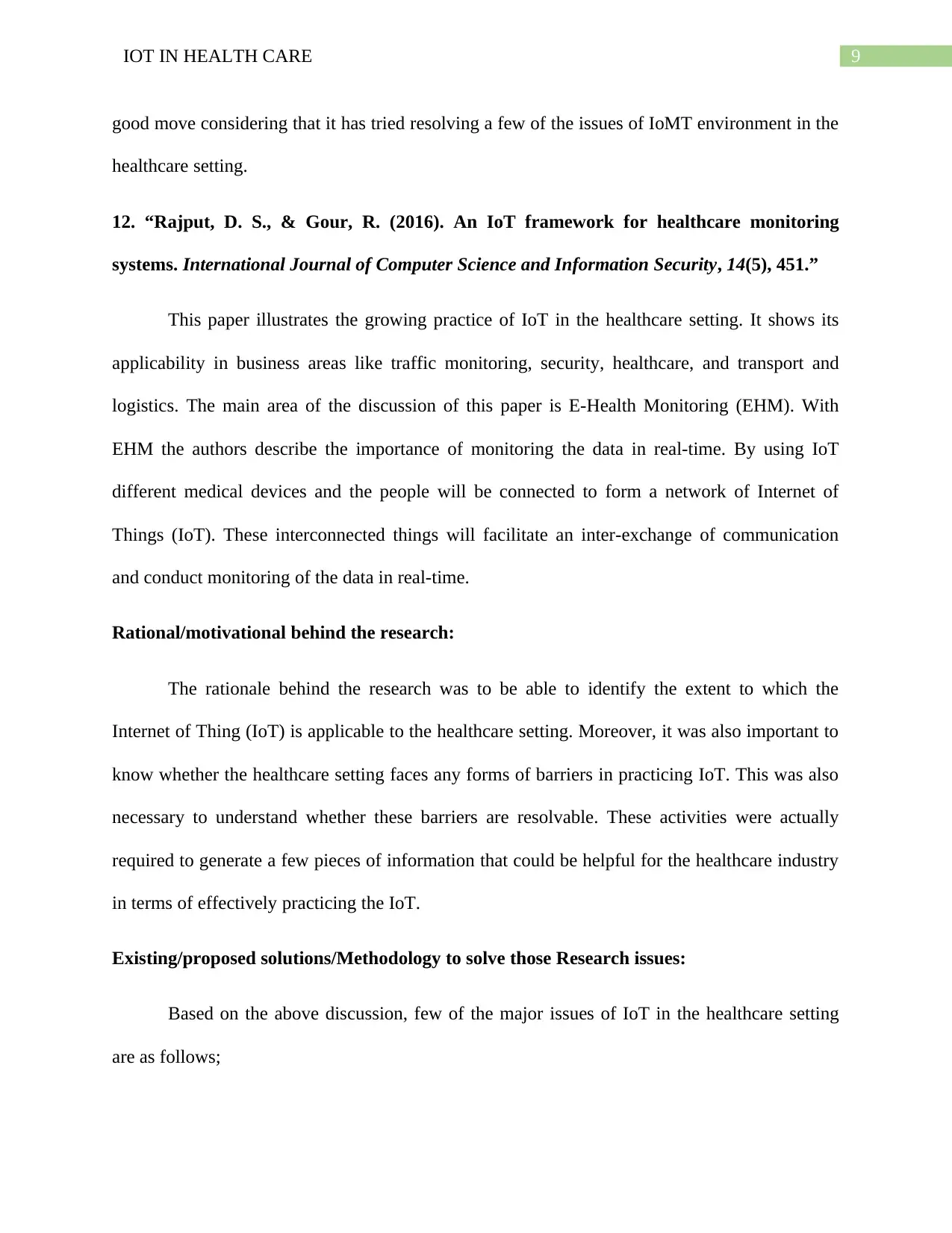
9IOT IN HEALTH CARE
good move considering that it has tried resolving a few of the issues of IoMT environment in the
healthcare setting.
12. “Rajput, D. S., & Gour, R. (2016). An IoT framework for healthcare monitoring
systems. International Journal of Computer Science and Information Security, 14(5), 451.”
This paper illustrates the growing practice of IoT in the healthcare setting. It shows its
applicability in business areas like traffic monitoring, security, healthcare, and transport and
logistics. The main area of the discussion of this paper is E-Health Monitoring (EHM). With
EHM the authors describe the importance of monitoring the data in real-time. By using IoT
different medical devices and the people will be connected to form a network of Internet of
Things (IoT). These interconnected things will facilitate an inter-exchange of communication
and conduct monitoring of the data in real-time.
Rational/motivational behind the research:
The rationale behind the research was to be able to identify the extent to which the
Internet of Thing (IoT) is applicable to the healthcare setting. Moreover, it was also important to
know whether the healthcare setting faces any forms of barriers in practicing IoT. This was also
necessary to understand whether these barriers are resolvable. These activities were actually
required to generate a few pieces of information that could be helpful for the healthcare industry
in terms of effectively practicing the IoT.
Existing/proposed solutions/Methodology to solve those Research issues:
Based on the above discussion, few of the major issues of IoT in the healthcare setting
are as follows;
good move considering that it has tried resolving a few of the issues of IoMT environment in the
healthcare setting.
12. “Rajput, D. S., & Gour, R. (2016). An IoT framework for healthcare monitoring
systems. International Journal of Computer Science and Information Security, 14(5), 451.”
This paper illustrates the growing practice of IoT in the healthcare setting. It shows its
applicability in business areas like traffic monitoring, security, healthcare, and transport and
logistics. The main area of the discussion of this paper is E-Health Monitoring (EHM). With
EHM the authors describe the importance of monitoring the data in real-time. By using IoT
different medical devices and the people will be connected to form a network of Internet of
Things (IoT). These interconnected things will facilitate an inter-exchange of communication
and conduct monitoring of the data in real-time.
Rational/motivational behind the research:
The rationale behind the research was to be able to identify the extent to which the
Internet of Thing (IoT) is applicable to the healthcare setting. Moreover, it was also important to
know whether the healthcare setting faces any forms of barriers in practicing IoT. This was also
necessary to understand whether these barriers are resolvable. These activities were actually
required to generate a few pieces of information that could be helpful for the healthcare industry
in terms of effectively practicing the IoT.
Existing/proposed solutions/Methodology to solve those Research issues:
Based on the above discussion, few of the major issues of IoT in the healthcare setting
are as follows;
Paraphrase This Document
Need a fresh take? Get an instant paraphrase of this document with our AI Paraphraser

10IOT IN HEALTH CARE
Communication between interconnected things
Exchange of knowledge between them
Battery lifecycle of the wearable and smartphone devices
Energy management
To identify the appropriate solutions to the issues highlighted as above, more research works
in the Australian healthcare setting is required. To serve this purpose, 9 to 10 major healthcare
companies in Australia will be investigated. The methodology will include collecting primary
data online surveys and questionnaire. The findings of the research works will help to understand
the issues more elaborately and also identify the relevant solutions.
Experimental analysis:
Based on the above discussion, it can be said that there exists a strong relationship
between Internet of Thing (IoT) and the healthcare industry. The healthcare industry as being
understood from the research is increasingly getting driven by IoT. However, it faces certain
challenges, which are stopping IoT to grow to a wider healthcare setting. Until and unless these
barriers are resolved there won’t be a wider application of IoT in the healthcare industry.
Conclusion:
To conclude, it can be said that the Internet of Thing (IoT) will expectedly occupy a
larger space in the healthcare setting in days to come. However, it depends on how healthcare
companies respond to a few barriers, which are stopping IoT to bloom across the healthcare
setting. IoT can be a potential move towards increasing operations efficiency and customer
service. However, this will require an appropriate identification and implementation of resources
to outdone the identified barriers and promote a healthy IoT practice.
Communication between interconnected things
Exchange of knowledge between them
Battery lifecycle of the wearable and smartphone devices
Energy management
To identify the appropriate solutions to the issues highlighted as above, more research works
in the Australian healthcare setting is required. To serve this purpose, 9 to 10 major healthcare
companies in Australia will be investigated. The methodology will include collecting primary
data online surveys and questionnaire. The findings of the research works will help to understand
the issues more elaborately and also identify the relevant solutions.
Experimental analysis:
Based on the above discussion, it can be said that there exists a strong relationship
between Internet of Thing (IoT) and the healthcare industry. The healthcare industry as being
understood from the research is increasingly getting driven by IoT. However, it faces certain
challenges, which are stopping IoT to grow to a wider healthcare setting. Until and unless these
barriers are resolved there won’t be a wider application of IoT in the healthcare industry.
Conclusion:
To conclude, it can be said that the Internet of Thing (IoT) will expectedly occupy a
larger space in the healthcare setting in days to come. However, it depends on how healthcare
companies respond to a few barriers, which are stopping IoT to bloom across the healthcare
setting. IoT can be a potential move towards increasing operations efficiency and customer
service. However, this will require an appropriate identification and implementation of resources
to outdone the identified barriers and promote a healthy IoT practice.
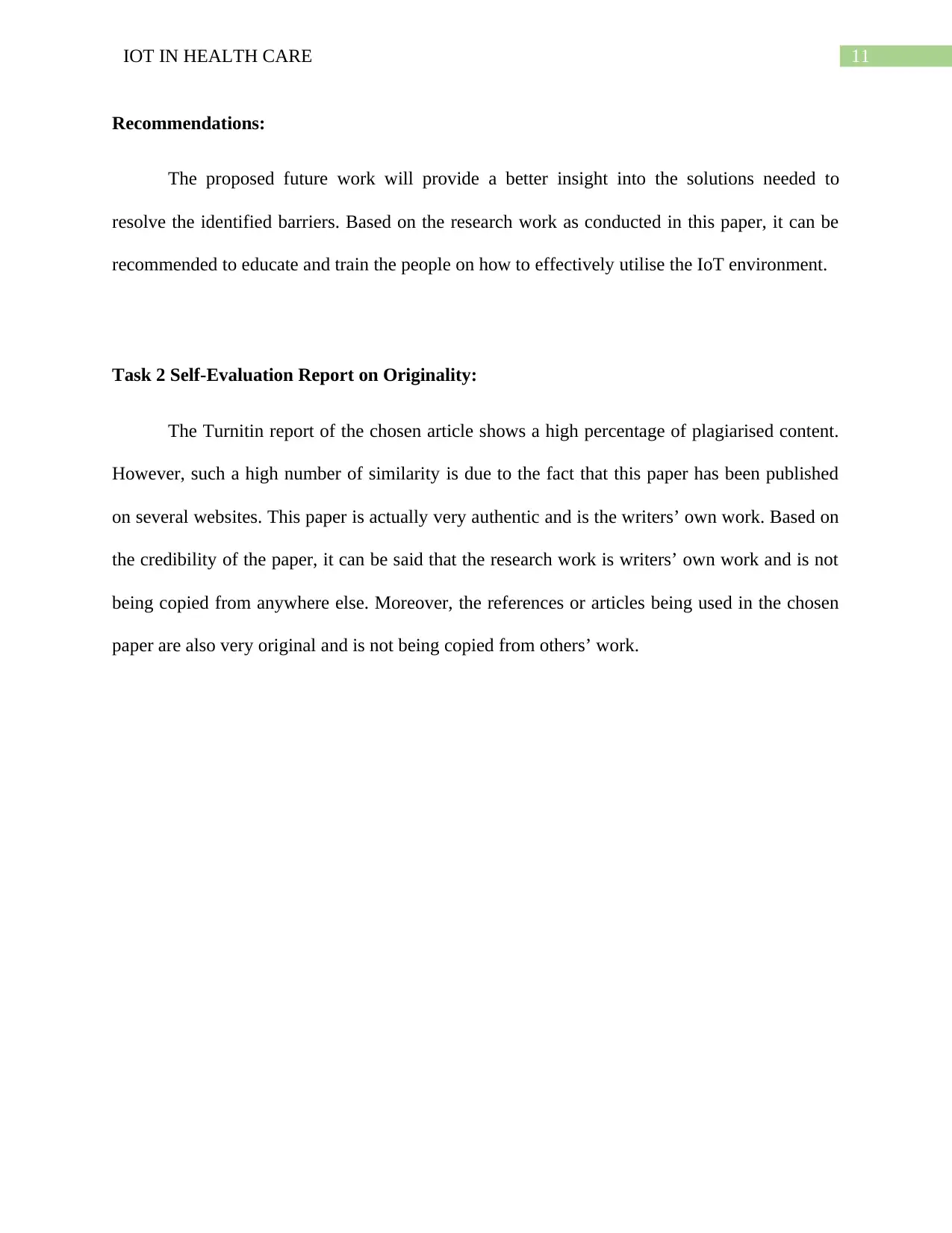
11IOT IN HEALTH CARE
Recommendations:
The proposed future work will provide a better insight into the solutions needed to
resolve the identified barriers. Based on the research work as conducted in this paper, it can be
recommended to educate and train the people on how to effectively utilise the IoT environment.
Task 2 Self-Evaluation Report on Originality:
The Turnitin report of the chosen article shows a high percentage of plagiarised content.
However, such a high number of similarity is due to the fact that this paper has been published
on several websites. This paper is actually very authentic and is the writers’ own work. Based on
the credibility of the paper, it can be said that the research work is writers’ own work and is not
being copied from anywhere else. Moreover, the references or articles being used in the chosen
paper are also very original and is not being copied from others’ work.
Recommendations:
The proposed future work will provide a better insight into the solutions needed to
resolve the identified barriers. Based on the research work as conducted in this paper, it can be
recommended to educate and train the people on how to effectively utilise the IoT environment.
Task 2 Self-Evaluation Report on Originality:
The Turnitin report of the chosen article shows a high percentage of plagiarised content.
However, such a high number of similarity is due to the fact that this paper has been published
on several websites. This paper is actually very authentic and is the writers’ own work. Based on
the credibility of the paper, it can be said that the research work is writers’ own work and is not
being copied from anywhere else. Moreover, the references or articles being used in the chosen
paper are also very original and is not being copied from others’ work.
⊘ This is a preview!⊘
Do you want full access?
Subscribe today to unlock all pages.

Trusted by 1+ million students worldwide
1 out of 14
Related Documents
Your All-in-One AI-Powered Toolkit for Academic Success.
+13062052269
info@desklib.com
Available 24*7 on WhatsApp / Email
![[object Object]](/_next/static/media/star-bottom.7253800d.svg)
Unlock your academic potential
Copyright © 2020–2025 A2Z Services. All Rights Reserved. Developed and managed by ZUCOL.




